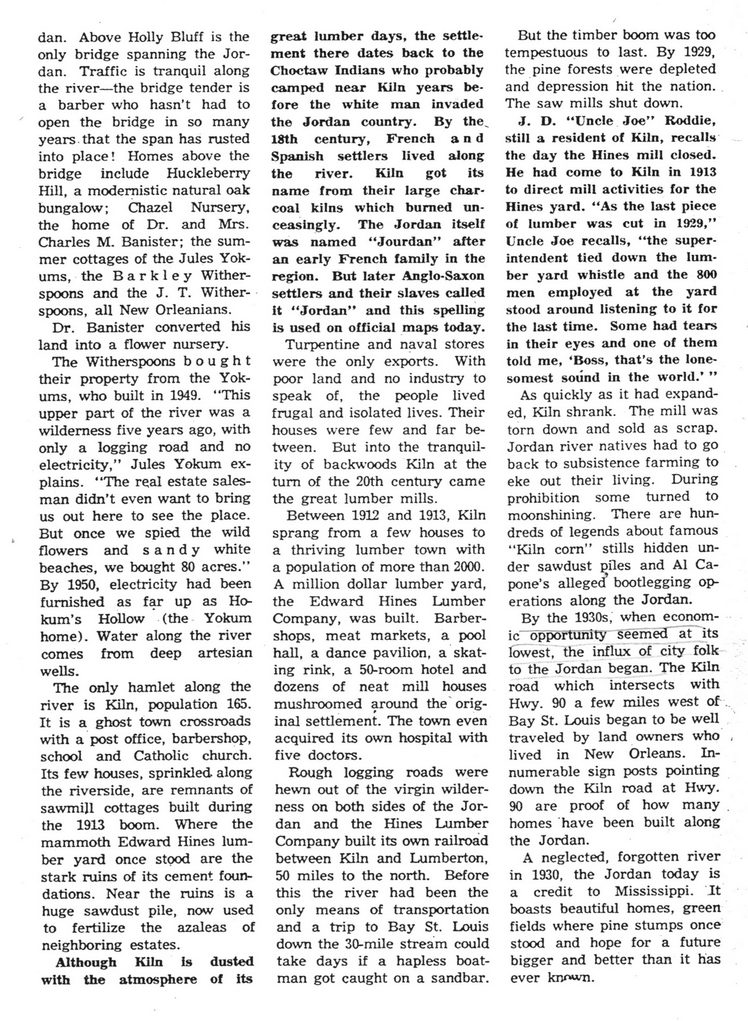This text was obtained via automated optical character recognition.
It has not been edited and may therefore contain several errors.
dan. Above Holly Bluff is the only bridge spanning the Jordan. Traffic is tranquil along the river—the bridge tender is a barber who hasn’t had to open the bridge in so many years that the span has rusted into place! Homes above the bridge include Huckleberry Hill, a modernistic natural oak bungalow; Chazel Nursery, the home of Dr. and Mrs. Charles M. Banister; the summer cottages of the Jules Yok-ums, the Barkley Witherspoons and the J. T. Witherspoons, all New Orleanians. Dr. Banister converted his land into a flower nursery. The Witherspoons bought their property from the Yok-ums, who built in 1949. “This upper part of the river was a wilderness five years ago, with only a logging road and no electricity,” Jules Yokum explains. “The real estate salesman didn’t even want to bring us out here to see the place. But once we spied the wild flowers and sandy white beaches, we bought 80 acres.” By 1950, electricity had been furnished as far up as Hokum’s Hollow (the Yokum home). Water along the river comes from deep artesian wells. The only hamlet along the river is Kiln, population 165. It is a ghost town crossroads with a post office, barbershop, school and Catholic church. Its few houses, sprinkled along the riverside, are remnants of sawmill cottages built during the 1913 boom. Where the mammoth Edward Hines lumber yard once stood are the stark ruins of its cement foundations. Near the ruins is a huge sawdust pile, now used to fertilize the azaleas of neighboring estates. Although Kiln is dusted with the atmosphere of its great lumber days, the settlement there dates back to the Choctaw Indians who probably camped near Kiln years before the white man invaded the Jordan country. By the 18th century, French and Spanish settlers lived along the river. Kiln got its name from their large charcoal kilns which burned unceasingly. The Jordan itself was named “Jourdan” after an early French family in the region. But later Anglo-Saxon settlers and their slaves called it “Jordan” and this spelling is used on official maps today. Turpentine and naval stores were the only exports. With poor land and no industry to speak of, the people lived frugal and isolated lives. Their houses were few and far between. But into the tranquility of backwoods Kiln at the turn of the 20th century came the great lumber mills. Between 1912 and 1913, Kiln sprang from a few houses to a thriving lumber town with a population of more than 2000. A million dollar lumber yard, the Edward Hines Lumber Company, was built. Barbershops, meat markets, a pool hall, a dance pavilion, a skating rink, a 50-room hotel and dozens of neat mill houses mushroomed around the original settlement. The town even acquired its own hospital with five doctors. Rough logging roads were hewn out of the virgin wilderness on both sides of the Jordan and the Hines Lumber Company built its own railroad between Kiln and Lumberton, 50 miles to the north. Before this the river had been the only means of transportation and a trip to Bay St. Louis down the 30-mile stream could take days if a hapless boatman got caught on a sandbar. But the timber boom was too tempestuous to last. By 1929, the pine forests were depleted and depression hit the nation. The saw mills shut down. J. D. “Uncle Joe” Roddie, still a resident of Kiln, recalls the day the Hines mill closed. He had come to Kiln in 1913 to direct mill activities for the Hines yard. “As the last piece of lumber was cut in 1929,” Uncle Joe recalls, “the superintendent tied down the lumber yard whistle and the 800 men employed at the yard stood around listening to it for the last time. Some had tears in their eyes and one of them told me, ‘Boss, that’s the lone-somest sound in the world.’ ” As quickly as it had expanded, Kiln shrank. The mill was torn down and sold as scrap. Jordan river natives had to go back to subsistence farming to eke out their living. During prohibition some turned to moonshining. There are hundreds of legends about famous “Kiln corn” stills hidden under sawdust piles and A1 Capone's alleged’ bootlegging operations along the Jordan. By the 1930s, when economic opportunity seemed at its lowest, the influx of city folk to the Jordan began. The Kiln road which intersects with Hwy. 90 a few miles west of Bay St. Louis began to be well traveled by land owners who lived in New Orleans. Innumerable sign posts pointing down the Kiln road at Hwy. 90 are proof of how many homes have been built along the Jordan. A neglected, forgotten river in 1930, the Jordan today is a credit to Mississippi. It boasts beautiful homes, green fields where pine stumps once stood and hope for a future bigger and better than it has ever known.

Holly Bluff Rediscovery-of-the-Jordan-Times-Picayune-1953-(3)